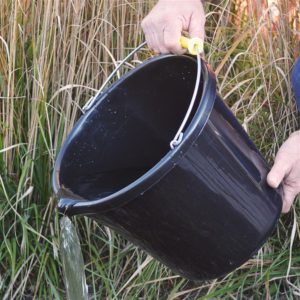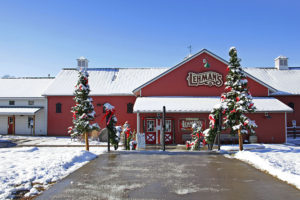
The smells were near heavenly: a faint hint of hickory and oak wood smoke masked heavily by the scents of salt pork and homemade sourdough biscuits which still lingered in the air leftover from breakfast before sunup.
My little “Granny” Smith would be clanging skillets and pans on the cast iron wood stove top or sifting flour at the Hoosier hutch, all in preparation for the magnificent lunch spread being prepared for all the family. Mom and the other ladies of the next generation would be playing second fiddle, handing the matriarch of the family ingredients, putting used cookware in the sink for washing, or setting the table for the wonderful feast to come.
It was Christmas morning, or Thanksgiving, or butchering day or any other reason the family had gathered at the family farm. A portion of the farm has been in our family since the mid-1800s. Grandpa inherited that tract from his grandmother, then added seven more neighboring pieces of land to make up the homestead where he and grandma raised cattle and chickens, made garden, grew timber, operated a tiny blacksmith shop and raised their family during the early years.
While grandpa kept the cattle fed and the equipment running, and their grown children and grandchildren often spent Saturdays and holidays helping out, it was grandma and her six-burner wood cookstove that kept the whole operation going.

Cooking with wood is a completely different experience than preparing a meal on a gas or electric range. It’s the equivalent of riding in an enclosed car from one place to another, or taking the same trip on a bicycle, motorbike or by walking. By taking the extra effort to get to your destination, you experience so much more of what surrounds you.
If you’ve never experienced cooking on a woodstove, a great starting place is the book “American Wood Heat Cookery” by Margaret Byrd Adams. It offers “almost three hundred dishes you can make on your heating stove, from soups to sweets. Methods (ash cookery, steaming, broiling, more), cookware and utensils, stove care, wood tips and proper fire temperature.” You’ll come away from the pages almost smelling and hearing the same smells and sounds I recall each time I think of grandma’s kitchen.

Grandma’s stove is a bit of a mystery. The only marking I’ve found on it is a small badge on the warming shelf which reads “Iron Master”. The front, sides and warming shelf are a mottled pink and white ceramic coat. The stove has six burners with removable top sections for service and cleaning, the small fire box on the right with access by a door on the front or a small flap on the cooktop surface. The oven has a thermometer on the door. To the left of the oven is another small door to access the copper water tank spout. The tank is filled from an access door in the cooktop. The spout pivots down to pour, or up to close the valve and hold the heated water inside. A damper built into the back of the stove is controlled by a sliding handle near the left rear of the cook surface.
Grandma cooked on that stove at least from before I was born more than 50 years ago up until she and grandpa had to leave the farm due to health reasons and move in with their children some 20 years ago. I’m not sure how long she had the stove before I came along. For the past two decades it had sat unused in the kitchen at the old farmhouse. The farm sits unoccupied these days with the exception of hunting seasons when I join my dad, siblings and some of our next generation to “camp” at the old house. We’ve always used the Ben Franklin stove in the front room for both heating and cooking. But when the roof began leaking over the kitchen this past year the decision was made to save the cookstove from inevitable ruin if something wasn’t done.
During the opening weekend of this fall’s deer season my son and I, along with the help of a couple good friends and hunting buddies, disassembled and removed and loaded the antique cookstove onto a waiting utility trailer. I took it home to my workshop — where I usually rebuild antique tractors and trucks — and reassembled it on a temporary roll-around wood base. Over these winter months I intend to refurbish this classic piece of family cooking history and put it back into use.
You don’t have to source an antique to enjoy the beauty and simple joys of cooking on a woodstove. Lehman’s carries several classic, ornate or utilitarian wood cookstove models at very affordable prices compared to modern kitchen appliances. Not only can you find stoves from Baker’s Choice, Heartland, Pioneer, Elmira, or the magnificent Waterford brand, but you can also order literature about all of Lehman’s wood cookstoves.
IMPORTANT NOTE FROM LEHMAN’S: We carry and offer all of the brands and stoves mentioned in this article. However, due to our inventory system, some are shown as “out of stock” on our website. This is because we special order these stoves when an order is placed. We’ve been selling wood cookstoves for more than 60 years, and our stove experts are ready to help you find the right stove for YOUR home or cabin. Please call us at 800-438-5346 for more information on any of our wood cookstoves.

And whether you have a refurbished stove like I do, or a more modern reproduction or utilitarian stove, you can find parts and accessories as well. Lehman’s carries lid lifters, coal/wood grates and many other parts and add-ons including optional water heaters, side shelves and warming shelves and heat shields.

Of course, you can also find pots and pans which work great with wood cookstoves, including a full line of cast iron cookware and other all-steel skillets and pans. You’ll want a small fire poker, ash container, maybe some leather gloves and fire starters. And don’t forget some stove polish.

Even though it’s been more than 20 years since I saw little granny standing in front of her stove with meats frying, sauces simmering and cornbread or rolls staying toasty on the warming shelf, my mind and my senses go back to those days each time I look at that porcelain and cast iron work of art. With any luck our (future) grandchildren will someday witness my wife and I cooking an occasional meal on that same (refurbished) wood cookstove. The “good ole” days don’t have to be just memories … you can make your own today with your own wood-burning cookstove.





























